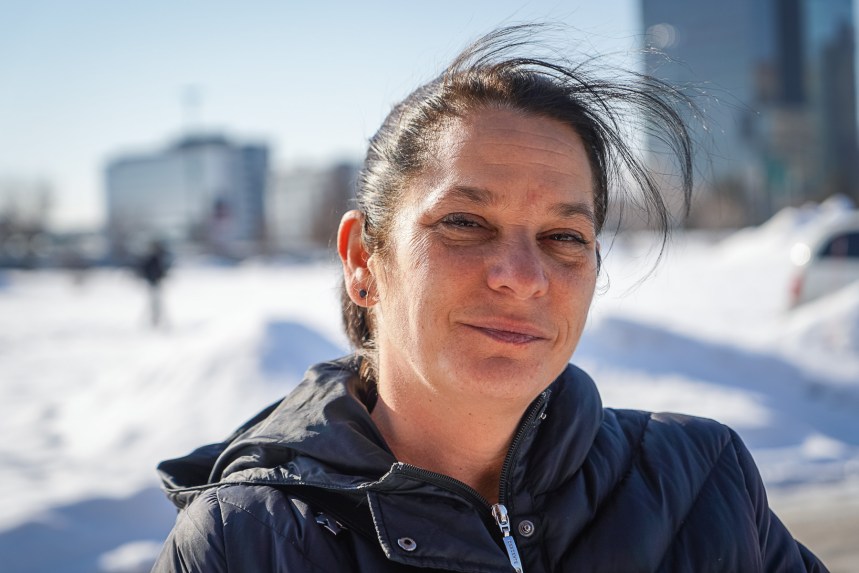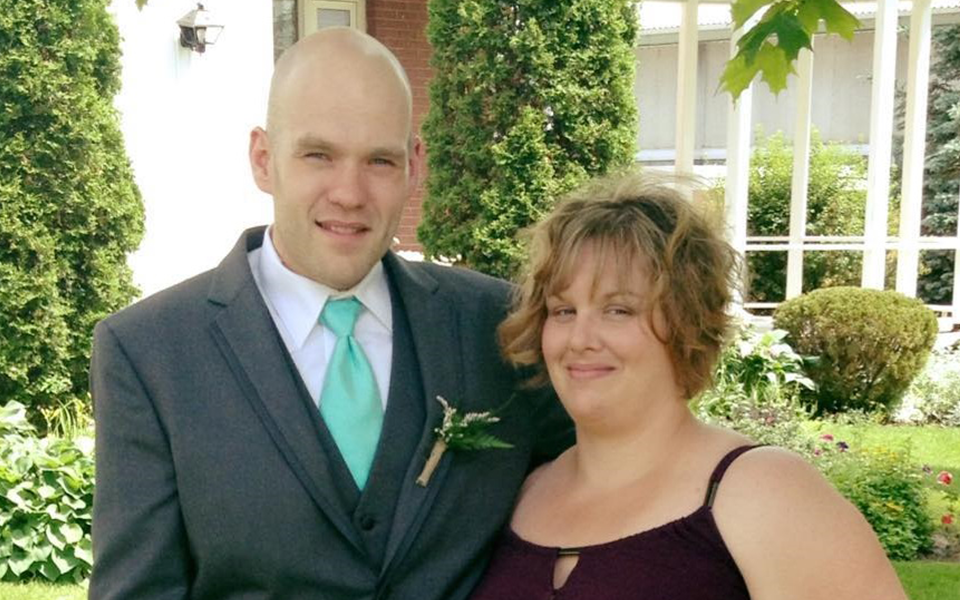The Neuro solves a medical mystery
Sophie Jodouin was a medical mystery. Her violent, repeated epileptic seizures baffled every doctor she met. Finally, a team at The Neuro cracked the mystery.

For more than a decade, Sophie Jodouin was a medical mystery. Her violent, repeated epileptic seizures baffled every doctor she met. Finally, two years ago, a team at The Neuro cracked the mystery.
"When Dr. Andrea Bernasconi told me the cause, I said, "You're kidding, right?'" recalls Sophie, 35, a lifelong resident of Ottawa. “For years I was told that I was such a baffling case."
Her tribulations started at 15 when she had her first tonic-clonic seizures in which muscles at first stiffen and contract and then begin twitching rhythmically.
"My parents didn’t know much about it," says Sophie. "It was a somewhat stressful and hard time."
Sophie had to abide by doctors’ orders not to remain in the bathtub by herself or to keep doors closed. Friends could sleep over at her house but she could not sleep at theirs.
"My teenage years were controlled at a stage when I wanted to do different things. I couldn’t get a driver’s licence. When people look at someone with epilepsy, they don’t understand the impact that it has on that person and their families."
For a few years, medication kept her seizures under control, though occasionally she would experience them.
"I remember one seizure in the middle of the night when I woke up and couldn’t see. It went black for a few seconds and I started screaming."
L’épilepsie, la maladie sournoise qu’on ne veut pas voir

Martine Morotti, dont le fils est décédé à la suite d'une crise d’épilepsie. Photo by Josie Desmarais.
La première fois que Martine Morotti a vu son fils Jérémie faire une crise d’épilepsie, elle a cru qu’elle allait le perdre. «Il a convulsé, son corps s’est raidi, ses yeux se révulsaient, il avait de l’écume sur le bord de la bouche», se remémore-t-elle. Depuis ses 13 ans, Jérémie était atteint de crises tonico-cloniques, touchant toutes les zones du cerveau. Au minimum une par mois, elles se déclenchaient toujours la nuit, jusqu’à ses 21 ans, lorsqu’il est mort à la suite d’une violente crise.
Aujourd’hui, Mme Morotti veut expliquer au plus grand nombre possible cette maladie sournoise. «Je veux que les gens sachent qu’il est possible de mourir d’épilepsie, comme c’est arrivé pour Jérémie», insiste-t-elle. La mère de famille veut parler de cette maladie, mais pas seulement pendant le Mois de l’épilepsie, qui commence ces jours-ci.
Le Dre Andrea Bernasconi, professeur de neurologie à l’Institut neurologique de Montréal s’intéresse de près à l’épilepsie. Au centre médical universitaire à l’Université McGill, il travaille sur un traitement chirurgical qui pourrait guérir la maladie.
«Il faut se rappeler que les médicaments contrôlent, mais ne guériront jamais l’épilepsie», mentionne l’épileptologue, qui précise que près de 60% des cas d’épileptiques peuvent être soignés par la médication. Jérémie était de ceux qui en ont essayé plusieurs types, sans succès.
Pour subir une chirurgie, l’épileptique doit être considéré comme «bon candidat». «En gros, il faut que la résonnance magnétique perçoive que l’origine des crises provient de la même partie du cerveau où il y a une anomalie», résume le docteur.
Bien que le champ épileptique de Jérémie ait été trouvé, il n’était pas prêt à subir une chirurgie. «Comme dans toutes chirurgies, surtout au cerveau, il y a des risques et il ne voulait pas prendre de chance», indique Mme Morotti.
Sophie Jodouin - Seizure free thanks to surgery
Using deep electrode implantation and thermocoagulation, doctors were able to identify the source of Sophie’s seizures and stop them

I was a young teenager and in perfect health, when suddenly I started having absence seizures at school. However, undiagnosed as such, I would often tell my mother how I got lost in the classroom or even in my room.
Four years ago, after a burnout from stress and being over tired at work, I seized non-stop for 140 hours and since then my life has never been the same. I was released from the hospital but started having seizures on the left side of my body three to four times a night and they were never able to stop or control them. My neurologist referred me to The Neuro.
Last year, in May, I was invited to take part in two weeks of EEG monitoring at The Neuro in the hopes of finding some answers. This was a chance of a lifetime! I met Dr. Martin Veilleux who was, at the time, the neurologist on staff on 3 North.
All the amazing nurses and staff cared for me very well. They provided support and knew exactly how to care for the special needs of each patient. It is a one-of-a-kind place, and I felt very lucky to be there. During my stay, I had the pleasure of meeting who I consider the Dream Team: Dr. Andrea Bernasconi and Dr. Neda Ladbon-Bernasconi, who were able to find the cause of my seizures through an MRI where they reconstructed my brain layer by layer, in 3D. They discovered a lesion that I have had since birth. This was the moment that changed everything.
Later on in October I had an appointment where I met Dr. Jeffery Hall and a couple of residents from out of the country. The plan was to have a surgery called deep electrode implantation. This is a procedure where they put electrodes directly on your brain to get more precise information to help target the cause or location of the seizures. I wasn’t nervous and I was more than ready.
There is a special something about Dr. Hall that puts you at ease, and having been there before, I knew I was in great hands. This was the right choice for me.
A year after I first walked into The Neuro I went in for my surgery, excited and ready for more answers. The team was amazing! Dr. Hall knew precisely where to put the electrodes to get the best results as the doctors had carefully mapped out my surgery beforehand.
If there is one thing I’ve learned about my visits and stays at The Neuro, it is that everything is done as a team and cases are never looked at by one independent doctor. As a patient there, I was privileged to have numerous doctors examine the results of my tests and talk about them collaboratively. The solution was found because of their teamwork and their combined skills.
After implantation I had the pleasure of being a patient of Dr. Birgit Frauscher’s. I have met many neurologists on this journey, but none as enthusiastic about their job or results as Dr. Frauscher. She is one of a kind and has been a gem throughout this process. Her passion for her work and her drive for success is exemplary and being under her care, I knew I was going to get the right results.
On May 16, I went for a second surgery called thermocoagulation. This is the process of putting electrodes directly in my lesion and burning it. What a fantastic experience and one I will never forget. Since the procedure I have been seizure free and I truly feel I won the lottery.
I will go back for a follow-up with Dr. Hall and Dr. Frauscher to ensure everything is going as expected. I cannot thank these doctors enough for their determination, expertise and their compassion. They gave me the best gift of all, they gave me my life back after 21 years.
This was a long journey for me but it ended well. I’d also like to thank all the staff of 3 North, the staff down at EEG, Lorraine and Nicole, Chun Ip, Nathalie Cloutier-Fons, the many volunteers, and all the other doctors and residents who worked on my case.